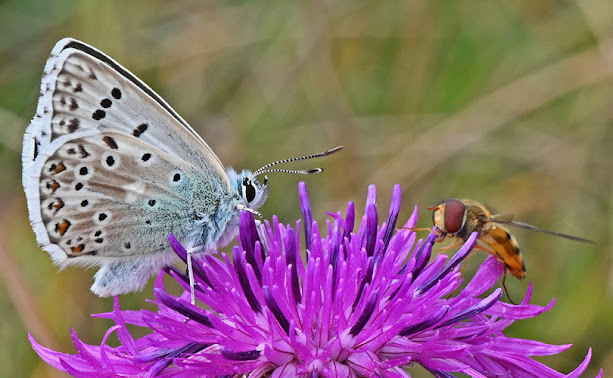Back from holiday early on the 3rd and with an enormous amount of sleep to catch up on, I nevertheless managed a short evening walk on the same day along the Greenwich Meridian Trail, south of Royston, where I knew that I would find hundreds of Essex Skippers. Most had clearly been on the wing for a few days and were looking rather ragged, but I did manage to get a few photos of decent specimens in what is a very large colony. As expected, Chalkhill Blues and Gatekeepers had emerged (the first Chalkhills were reported on the 25th of June, the day I left the UK). Marbled Whites were still flying on The Heath when I visited on the 4th. Chalkhill Blues were seen in relatively small numbers, but very large numbers of Gatekeepers were seen. The first of the second generation of Brown Argus were already on the wing, very early but in line with other butterfly species that have emerged early in what promises to be a long, hot summer.
Royston Wildlife Blog
Tuesday, 8 July 2025
Local Wildlife Sightings, July 2025
UK Wildlife Sightings, July 2025
I'll post here when I've been somewhere in the UK other than Hertfordshire and South Cambridgeshire - watch this space.
Thursday, 5 June 2025
Local Wildlife Sightings June 2025
After an impressively warm and sunny spring, it was back to changeable weather in June with a few warm, sunny days interspersed with showers and longer periods of rain. I took the opportunity on the 2nd (a warm, sunny day) to visit local fields and Therfield Heath, looking mainly for butterflies. Numbers of first generation Common Blues and Brown Argus butterflies were falling now on The Heath, whilst I failed to find any Adonis Blues there. However, on the small wild flower patch in the field that is behind our estate, which has proved quite productive in the past, I was lucky to find a recently emerged male Common Blue, which flew conveniently towards me and perched on top of a flower bud, allowing me to take some nice photos. If only all insects were so obliging!
UK Wildlife Sightings June 2025
On the 2nd I made my annual pilgrimage to Glapthorn Cow Pasture NR (near Oundle in Northamptonshire) to see Black Hairstreak butterflies. Impressive numbers were on the wing, indicating that this species, at least, has not been adversely affected by the poor weather in 2024. I also saw my first Large Skipper of the year here.
On the 4th I returned to Bempton Cliffs to spend time with my brother and his family, who were holidaying in the area, and introduce them to the wonders of this RSPB reserve. My brother is a keen and very good photographer, but rarely photographs wildlife. However, whilst we were there he took 900 (admittedly, bracketed) images whilst I took very few! Here are a couple of my images.
On the 8th the final RSPB Local Group coach trip of the season took us to Snape Maltings (Suffolk), from where we explored both sides of the river Alde. I enjoyed close views of House Martins picking up mud from the river as the tide went out. Very few dragonflies were seen. Baby Lapwings and (I think) Redshanks were seen on the marshes to the north of the river, perhaps indicating a successful breeding season for these waders. A number of digger wasps (Colytes spp.) were photographed near the Maltings.
Tuesday, 6 May 2025
Local Wildlife Sightings May 2025
The hot weather continued into the start of May, with temperatures reaching around 27C, before declining dramatically as north-easterly winds set in from the 3rd. By the 4th the temperature in mid-afternoon was just 13C with a significant wind chill factor making it feel even colder, and I had gone from a light polo shirt to three layers, with a fleecy jacket on top. Whilst the weather was still hot on the 2nd I visited Church Hill and was encouraged to see at least ten (presumably) male Brown Argus butterflies flying over the low-cut grassy slopes, after this species did so badly in 2024. The cutting of the grass here in late summer last year should benefit this and other 'blue' species. Also seen were two Small Heath butterflies and small numbers of Peacock, Brimstone, Red Admiral, Comma, Orange Tip and Green-veined White butterflies.
The warm weather soon returned, with prolonged sunshine during the middle of the month. Back on Church Hill on the 7th I couldn't find any Brown Argus butterflies (they only live in the adult stage for a few days), although a single Common Blue butterfly was seen at the bottom of the hill, a very early Broad-bodied Chaser dragonfly was seen nearby and a Mother Shipton moth (also seen on the 2nd) was photographed. This attractive, day-flying moth has a beaky 'face' marking on each wing, presumably giving it its name: see if you can make it out on the image (below). I was pleased to see that two male Spotted Flycatchers were 'singing' (a few high-pitched, squeaky notes) in Fox Covert on either side of the Therfield Road. This is a very early return for a species that can turn up as late as the beginning of June, but there had already been several reports of this species before 'my' birds were seen.




















































